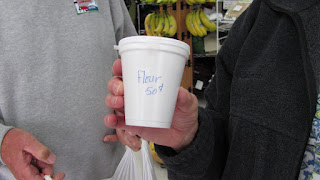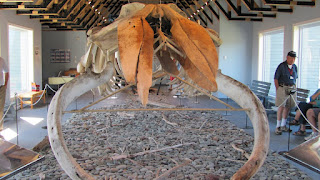The wind gusts were so strong, the wave would crash into rocks on the shoreline and splash up onto the highway, or hit vehicles passing by. We had no problems with the wind, however, several other RV'ers had awning damage due to wind blowing so strong, causing the awning to unfurl.
If you look on the road you can see where water had splashed up on the road from the waves crashing into the shoreline rocks.
The two photos above do not do the storm justice. The wind was blowing so hard, the surf was blowing on the vehicles going down the road.
A
The hurricane force winds tore this road sign apart. Man, was the wind blowing!
As we headed south we stopped along the way to explore. We found a small fishing village and bought these beautiful salmon fillets for that night's dinner.
The salmon fish were great!
But we also found flour for sale in cup-size containers. Look at the price for this small cup of flour.
"aux Basques" is the location of the ferry landing for the ferry heading back to Nova Scotia. We stayed at the Grand Codroy RV Park on Doyles Road, near the ferry landing, the night before we loaded on the ferry. The park was 15 miles from the ferry landing, so we drove "noise to tail" caravan style to the ferry. We all came in together to help sort out the ferry tickets. The ferry crossing was a six hour ferry ride in smooth seas on a beautiful day.
Leaving the RV park we were driving noise to tail, caravan style.
We were coming down the hill towards the ferry. You can see the ocean in the background.
We are coming up the ferry loading gates.
Once inside the loading area, we had to drive through a "de-contamination" booth. As we drove through, a chemical sprayed the undercarriage of the rig. Apparently, a certain mold commonly found in Newfoundland soil was not wanted in Nova Scotia. The process was painless, simply drive through.
Here is the ferry backing into the ferry loading slip. This is a huge ship, with two car decks.

The ferry is very slowly backing into the vehicle slip.
We finally got to load. A comment about Canadian ferry schedules, they are very loose. Meaning, if the schedule says it will leave at 3:00 pm, plan on 4:00 pm departure. It seems to be the accepted standard mode of operation for the government-operated ferry system.

We're off! We are leaving Newfoundland.
Here is Frank, Rita and Lee gathering for departure.
We are unloading from the car deck of the ferry. The loading and unloading process runs very well.
We headed to Louisburg, a Canadian Parks National Park. The Fortress of Louisburg is a National Historic Site of Canada. It is the largest historical society reconstruction in North America. As you weave your way through the cobblestone streets and buildings of this former French stronghold, your senses awaken with the sights, sounds and smells of an 18th-century fortress.
This city was built by the French for creating a process for the cod fish to be harvested and returned to France for consumption. Apparently, cod fish can be salted, and dried and shipped, not requiring refrigeration. When the cod was received in France, it could be soaked in water and reconstituted as fresh fish. This purpose built city was the jewel of France. But naturally, the British wanted it. So throughout the years several battles took place to see who would control Louisburg.
We had to drive through the countryside to get to the seaside town of Louisburg. There is a new Louisburg next to the historic fortress.
Here is a model of the layout of the original city.
The main building has been refurbished. This building housed officers of the military.
Lee with one of the characters dressed for that period.
This guy is preparing to give a "long gun" demonstration. A crude weapon indeed.
When he fired the gun, it sounded like a cannon. Also, it had a pretty kick to it.
The office of the General. Notice the stone work. These buildings were built using native stone.
We had a dinner one evening that was intended to mimic how people ate in the 1800s. We all ate under a tent and of course we had to all wear a hat of the period. We arrived late and the hat I got was not my first choice. It was all in good fun. A "winch" trolled through the dining area sitting on guys' laps. Well, guess who she picked? We enjoyed the evening, and, of course, the entertainment!
The next day we boarded a ferry for our trip to Prince Edward Island. The one-hour ferry ride was uneventful, but interesting. The roads were narrow on PEI, but we were able to find the RV park without incident.
Loading the PEI ferry.
One of the surprises we had while on PEI was getting a history lesson on "Anne of Green Gables". I remember hearing of this book, but did not realize the significance of the book in other countries. For example, Japan uses the book as mandatory reading for their school system. Needless to say, there were many more Japanese tourists here than Americans.
Lucy Maud Montgomery was actually the author of the book. She lived on PEI and based the content in the book around her grandparents farm.
The barn at the "Green Gables".
The farm house.
We had our farewell dinner at a local church. The food was great and fellowship was excellent.
Here is Rita with her lobster eating bid on. All lobster eaters were wearing them.
Here are all the PEI lobsters ready for eating. My lobster was great.
Yummy!
This trip to the Canadian Maritimes was a major trip for us. We especially enjoyed the history lessons we learned about Canada. It became so obvious to me that Canadians know much more about American history thnt Americans know about Canadian history.
I would recommend this trip to anyone.
































































